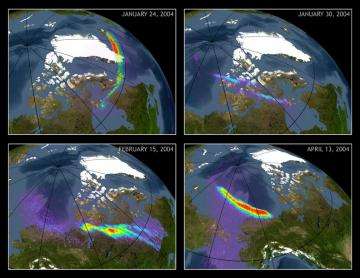A team of scientists observed Earth’s north polar region ten times during a four-month period in 2004. As the bright arcs in this sample of images show, they discovered low-energy (0.1 - 10 kilo electron volts) X-rays generated during auroral activity. Other satellite observatories had previously detected high-energy X-rays from Earth’s auroras. The images – seen here superimposed on a simulated image of the Earth – are from approximately 20-minute scans during which Chandra was pointed at a fixed point in the sky while the Earth’s motion carried the auroral region through the field of view. The color code of the X-ray arcs represents the brightness of the X-rays, with maximum brightness shown in red. (Credit: NASA/MSFC/CXC/A.Bhardwaj & R.Elsner, et al.; Earth model: NASA/GSFC/L.Perkins & G.Shirah)
In an unusual observation, a team of scientists has scanned the northern polar region of Earth with NASA's Chandra X-ray Observatory. The results show that the aurora borealis, or "northern lights," also dance in X-ray light, creating changing bright arcs of X-ray energy above the Earth's surface.
While other satellite observations had previously detected high-energy X-rays from the Earth auroras, the latest Chandra observations reveal low-energy X-rays generated for the first time during auroral activity.
The researchers, led by Dr. Ron Elsner of NASA's Marshall Space Flight Center in Huntsville, Ala., used Chandra to observe the Earth 10 times over a four-month period in 2004. The images were created from approximately 20-minute scans during which Chandra was aimed at a fixed point in the sky and the Earth's motion carried the auroral regions through Chandra's field of view.
From the ground, the aurora are known to change dramatically over time, and this is also the case in X-ray light. The X-rays in this sample of the Chandra observations, which have been superimposed on an approximate representation of the Earth, are seen here.
Auroras are produced by solar storms that eject clouds of energetic charged particles. These particles are deflected when they encounter the Earth's magnetic field, but in the process large electric voltages are created. Electrons trapped in the Earth's magnetic field are accelerated by these voltages and spiral along the magnetic field into the polar regions. There they collide with atoms high in the atmosphere and emit X-rays. Chandra has also observed dramatic auroral activity on Jupiter.
Dr. Anil Bhardwaj is the lead author on a paper describing these results in the Journal of Atmospheric and Solar-Terrestrial Physics. Dr. Bhardwaj was a co-investigator on this project and worked with Dr. Elsner at NASA's Marshall Space Flight Center while this research was conducted.
The research team also includes Randy Gladstone, Southwest Research Institute, San Antonio, Texas; Nikolai ьstgaard, University of Bergen, Norway; Hunter Waite and Tariq Majeed, University of Michigan, Ann Arbor; Thomas Cravens, University of Kansas, Lawrence; Shen-Wu Chang, University of Alabama, Huntsville; and Albert E. Metzger, Jet Propulsion Laboratory, Pasadena, Calif.
Source: Chandra X-ray Center
























